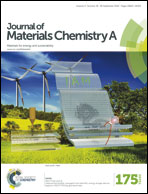A class of transition metal-oxide@MnOx core–shell structured oxygen electrocatalysts for reversible O2 reduction and evolution reactions†
Abstract
It is highly desirable but challenging to develop a highly active as well as durable bifunctional electrocatalyst for the reversible oxygen reduction reaction and evolution reaction (ORR & OER). Here a new class of bifunctional oxygen electrocatalysts has been developed based on ultrafine transition metal-oxide nanoparticles (NPs), such as NiO, FeO or NiFeO, embedded in an amorphous MnOx shell, where the embedded NP core contributes to the high OER activity and the porous amorphous MnOx shell functions as an effective ORR catalyst as well as providing effective structural confinement to the metal-oxide NP core. The best performance was obtained for NiFeO@MnOx, exhibiting a potential gap, ΔE, of 0.798 V to achieve a current of 3 mA cm−2 for the ORR and 5 mA cm−2 for the OER in 0.1 M KOH solution, better than that of Ir/C (0.924 V) and Pt/C (1.031 V). Most importantly, NiFeO@MnOx shows superior stability due to the outstanding structural confinement effect of the amorphous MnOx, achieving a ΔE of 0.881 V after 300 cycles, outperforming 1.093 V obtained for the state-of-the-art Ir–Pt/C oxygen electrocatalysts.



 Please wait while we load your content...
Please wait while we load your content...